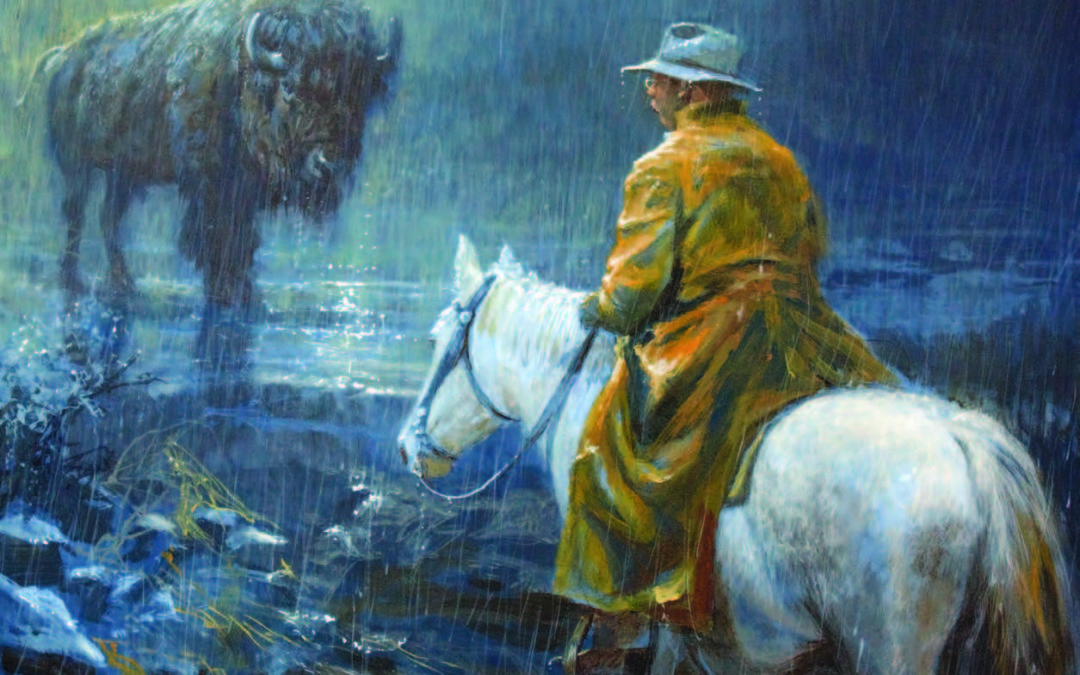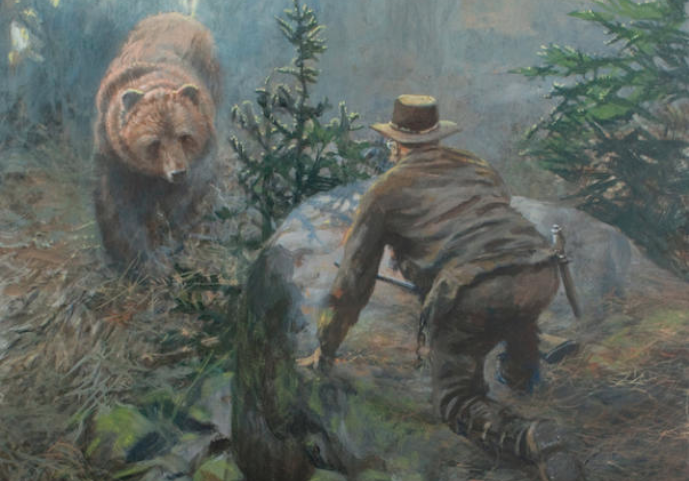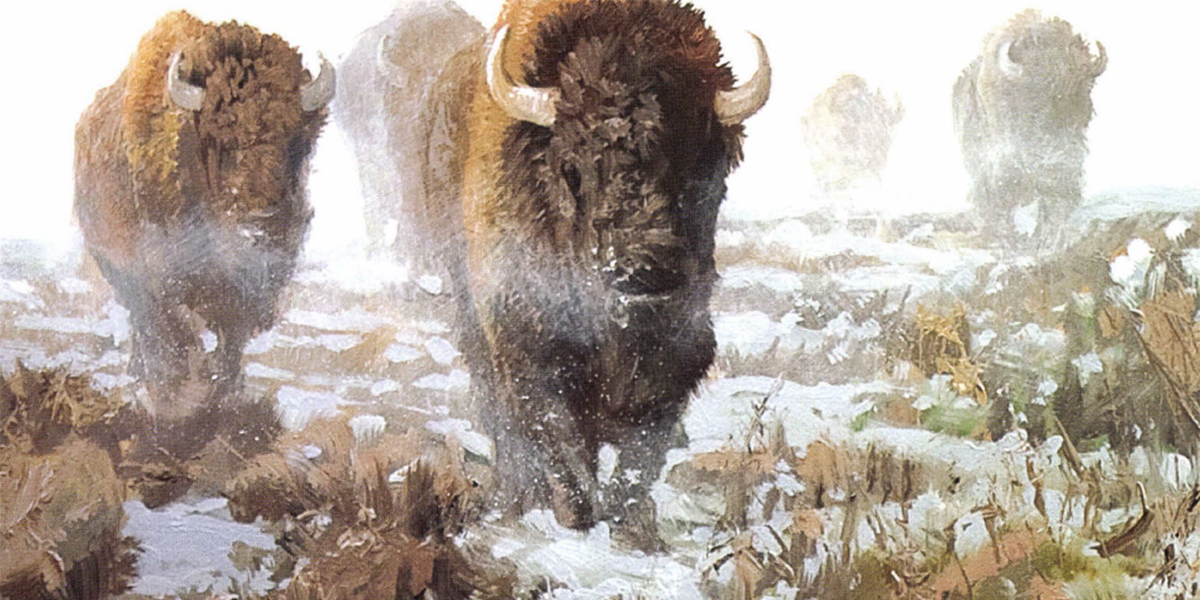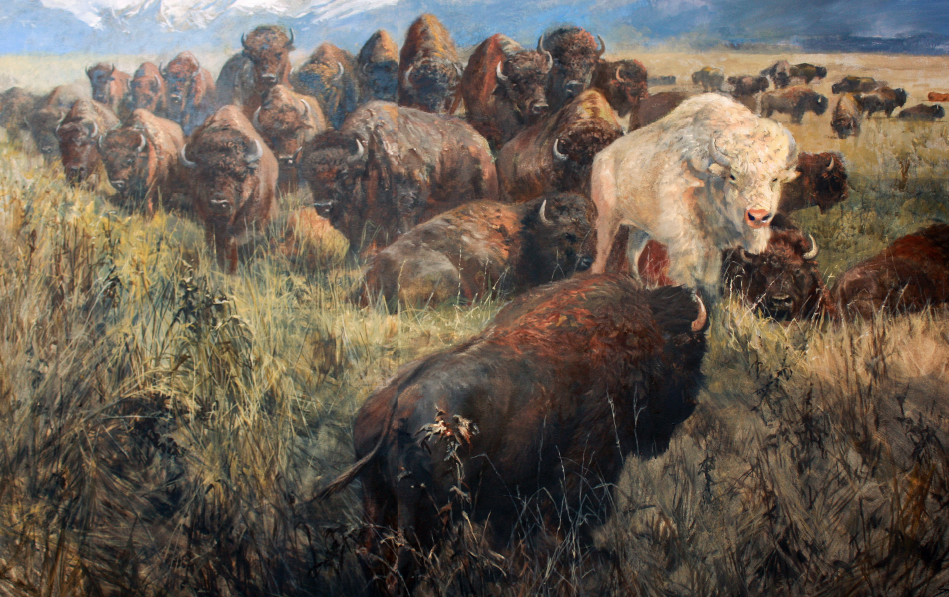He asked his top ranch hand, one of the Ferris brothers, to go with him on his first buffalo hunt. TR thought his local knowledge and, hopefully, his ability to find buffalo would prove invaluable on the short trip. They rounded up a couple of ponies, each carrying a blanket and a meager food supply stashed behind the saddles.
As they set out from camp on that unseasonably warm September morning, TR couldn’t have known what perils and frustration lay in store for them.
After crossing the Little Missouri River, they rode and weaved their way through one narrow gulley after another between the many high buttes. By midday the air was getting very hot, so they slowed down a little to prevent their mounts from getting tired. After only a few more hours they found what they were looking for: tracks of a bull buffalo in the soft mud at the bottom of a dry creek.
They estimated the bull was about two hours ahead of them. TR was excited about the find until Ferris dampened his enthusiasm by saying it was doubtful they could catch up to him. TR insisted that they at least try, however, so they set out after the animal.
The lone bison meandered up and down the narrow gullies, eventually leaving the soft ground to head up a winding coulee, where his tracks seemed to disappear on the sunbaked earth. The men carefully examined the hard ground and soon found some faint tracks, which led them to a steep cliff.
Suddenly an old buffalo broke from some bushes and began galloping and sliding down into the steep ravine. TR was amazed that the huge animal could navigate the cliff without falling.
The two men rode up to the edge and watched the wooly beast in amazement as it climbed almost effortlessly up another butte. At the top the bull paused to look back at its pursuers. Standing sideways against the sky, the bull’s shaggy mane and huge forequarters reminded TR of an African lion.
They followed the bull for many more miles until the hard ground once again concealed all traces of the animal. Just as Ferris had predicted, they never laid eyes on him again.
To appease his boss, Ferris suggested they proceed farther from the river, beyond the buttes to the prairie, where they would be sure to find bison.
They eventually reached the grasslands, where they found the occasional round-topped butte, low canyons some 30 feet deep cut by narrow and meandering creek beds. Although most of the creeks were dry, they did find one with water, where they refreshed themselves and their horses.
The air was hot and still as the men continued to ride across the barren land—a monotonous landscape with no sign of wildlife. By late afternoon TR was getting disheartened. They had even rode into some of the box canyons to look for bison, but without success.
The sun was now low in the sky as the men climbed out of yet another empty canyon and found themselves looking at a vast plain, in the middle of which they could see three black specks. Could they be buffalo? TR rode ahead of Ferris, then stopped and glassed the scene from the saddle. The specks were indeed buffalo, and they looked to be bulls.
TR’s spirits were instantly lifted. He was eager to go and bag one, but the horses were too tired to run anymore. They decided to stalk the bison on foot, even though there was very little in the way of cover.
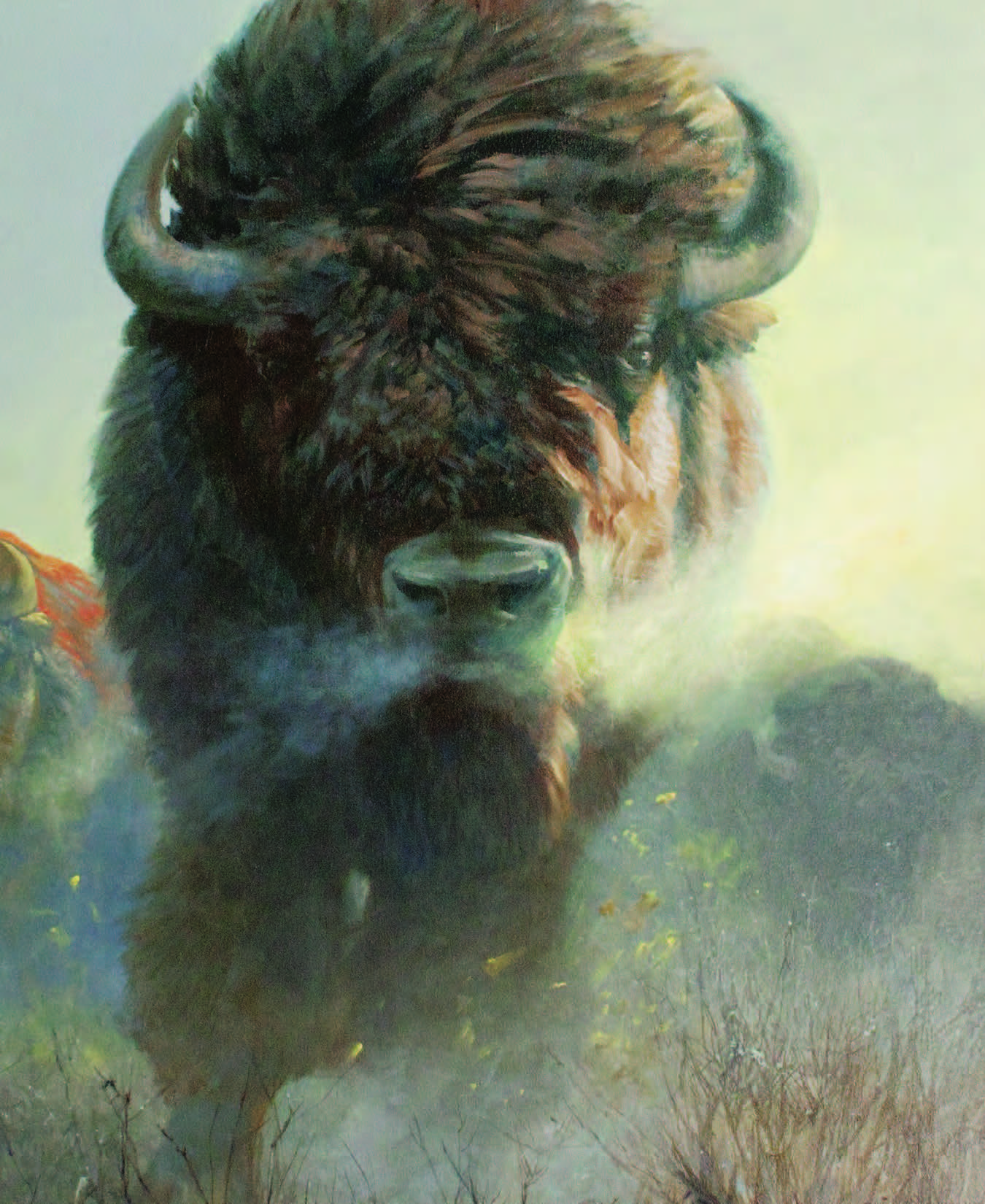
Running Out By John Seerey-Leser
They tethered the horses in a shady place, then chose the best route to creep up on the bulls, which were about a half-mile away. The terrain was uneven, but there were sage bushes to help conceal them as they crawled on hands and knees across the hard ground. In some places they laid flat and slithered like snakes around rocks and cacti. Several times TR had to stop along the way and pull spines from his hands.
They eventually crept to within 150 yards of the bulls, which were leisurely grazing, unaware of the hunters’ presence. TR’s view was unobstructed, so for the first time in his life he drew up and fired at a buffalo.
TR had selected the best-looking bull, which was broadside to him, but his aim was not good and his bullet struck the beast too far back. The noise and the sudden impact of the bullet startled, more than harmed, the bull, which turned and charged away, taking the other two bison with him. Their tails waving in the air, the three quickly vanished into a cloud of dust.
Both men were frustrated by what they’d just seen—TR more ashamed than anything—as they ran back for their ponies. They jumped onto their saddles and gave spur, chasing after the buffalo, which were already a mile ahead of them.
The horses were still tired and not able to reach top speed. As the chase continued and the horses slowed down, it seemed the buffalo were getting faster, putting more and more distance between them. even the wounded bull showed no sign of weakening.
For more than eight miles the men pursued their quarry until they had to bring their jaded horses to a halt and dismount. By then the sun had set, but the bison were still visible in the distant twilight. They, too, had come to a halt in a small hollow on the prairie.
The two men saw no alternative, so they remounted their tired ponies to make one last run at the beasts. TR reasoned that a quick spur would bring enough life to their mounts, enabling the men to get the bison within shooting distance.
The hunters cantered toward the buffalo so as not to alarm them, but at the last moment, the bulls turned to face the oncoming riders, then started to run off, the wounded animal peeling off to one side.
Seeing this, the men directed their attention toward the wounded bison and were able to gain on him just as the twilight was replaced by a rising full moon. Soon TR was within 70 yards of the bull, but his horse was faltering badly.
Ferris’ mount was strongest, so he took over the chase and rode toward the wounded buffalo. Then, at the last moment, the bull saw him and came charging in front of TR. Both men then turned their weary mounts and continued the chase.
They rode hard over the rough, moonlit prairie, pitted with holes and hillocks, following the bull until their exhausted mounts were pitching forward with every stride. They were all but done. As TR’s pony staggered to within 20 feet of the buffalo, he raised his rifle and fired from the saddle, but missed.
Suddenly the beast raised its tail and charged with lowered horns. TR’s horse spun around, throwing up its head, which struck TR’s gun and slammed it into his forehead. Blood poured from the gash, running into his eyes and blurring his vision.
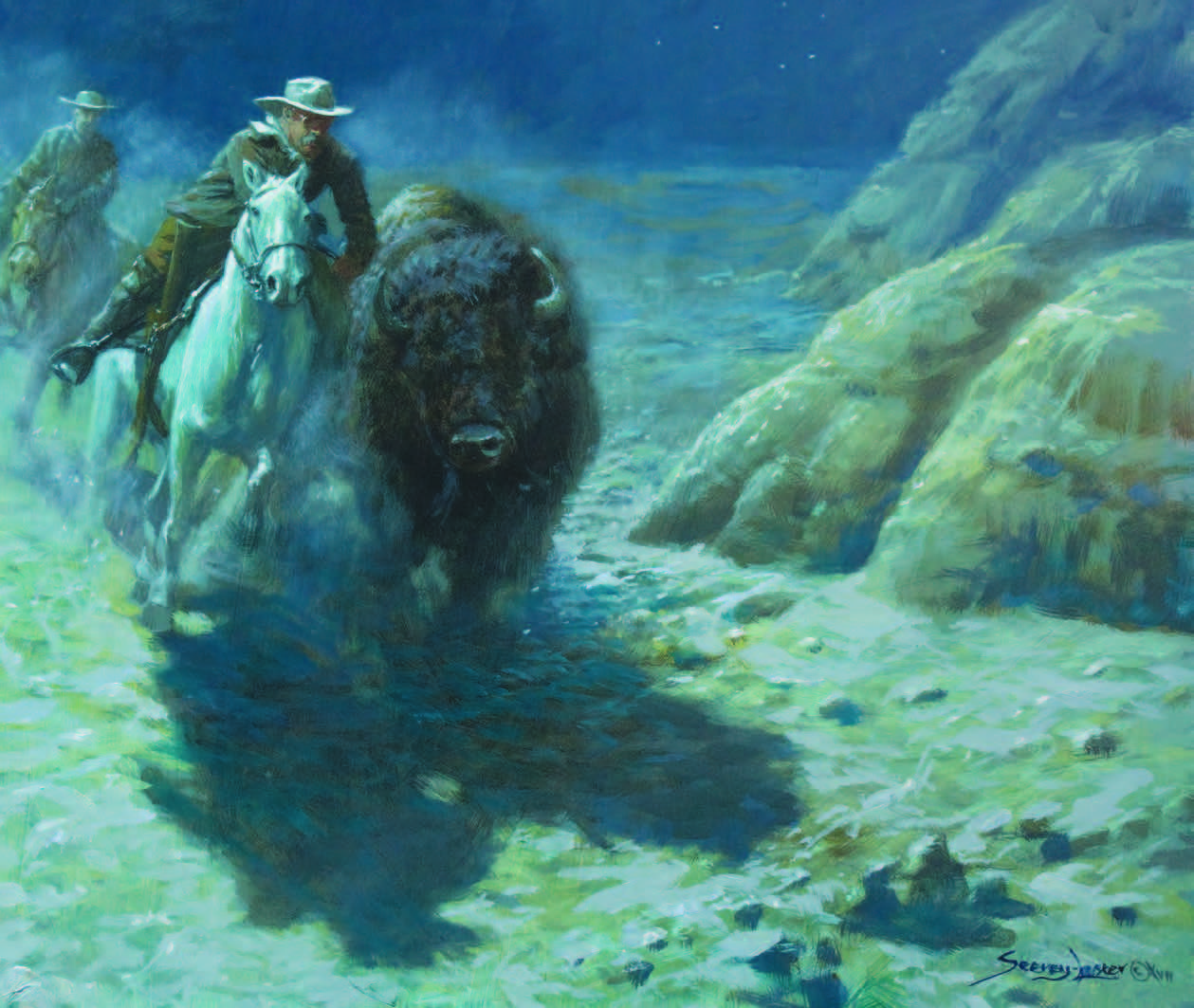
Clash Of The Titans By John Seerey-Lester
The buffalo then turned his attention to Ferris, charging him and his horse with lightning speed. Ferris turned and raced away, but like TR’s, his mount was very tired and the buffalo was soon right on his tail.
The chase lasted for several minutes in the moonlight, Ferris skillfully zigzagging his mount to avoid being gored. Finally, the bull broke away and the ranch hand was able to leap from his horse and take a couple of shots at the buffalo, though he missed both times in the dim light.
The exhausted men looked on in horror as the wounded bull turned and rambled off, quickly disappearing into the darkness. Rifle in hand, TR jogged after his prize for quite some distance until he simply ran out of breath.
A dejected TR rejoined Ferris, and the two hunters began to walk their thoroughly exhausted mounts over the moonlit prairie, heading back to their cow camp along the meandering Missouri River.
Theodore Roosevelt and his ranch hand were three days into TR’s first buffalo hunt that September in the late 1880s. They had been searching for the wooly beasts among buttes along the Little Missouri and had now reached the prairies several miles from the river.
So far, their hunt had been less than successful, although it had certainly been eventful. Everything that could go wrong had gone wrong. They had chased the wooly beasts through the high buttes, in and out of canyons and over the plains, by day and night, but so far had been unable to bring one down.
For TR this was most frustrating, particularly knowing that the buffalo had a reputation as being an easy hunt. Day after day he became more determined to get his trophy, which must have put a lot of pressure on Ferris.
Exhausted from the events of the first couple of days, the two men were now resting their horses by slowly walking them over the moonlit prairie. Man and beast were thoroughly worn out as they walked down into a dark ravine to make camp.
As they neared the bottom, they noticed a slight glistening among some reeds along what they thought was a dry riverbed. Moving closer, they realized it was the moonlight reflecting on the surface of a stream. The water was a welcome sight for the men, who had not had a drink for some 12 hours.
Both men and horses quenched their thirst in the muddy water, then the hunters sat down and devoured some biscuits. They decided the ravine would be a good place to bed down for the night, though there was no fuel to make a fire. So, after unsaddling the horses, they used their saddle blankets to lay on and their own blankets to cover themselves. The saddles were used as pillows, to which they tethered the ponies.

As the men settled in for the night, TR noticed that both horses seemed preoccupied with something off in the darkness. He could see their heads were alert and their ears were pricked forward, listening to something. The men, who could not see or hear anything, soon fell asleep, despite TR fearing being scalped by unfriendly Indians.
Around midnight they were awakened by the saddles being snatched from under their heads. TR jumped to his feet just in time to see the horses gallop over the rim of the ravine with the saddles bouncing behind them.
Ferris grabbed their rifles and followed TR out of the ravine to where they could see the marks left by the saddles being dragged through the dewy grass. Ferris said he’d seen wolves looking over the rim of the ravine, which probably spooked the ponies. The two men set off running after their mounts and saddles across the shimmering prairie.
They found the horses and the saddles only a half-mile from the ravine. They led the trembling horses back and re-tethered them before trying to get back to sleep, but they were once again disturbed around3 a.m. when it began to rain. They sat for a while shivering beneath their blankets before deciding to head on out.
By the time they rode out of the ravine and onto the plain, a fog had descended along with a steady drizzle. Soon they could hardly see where they were going and got turned around in the fog. They eventually resorted to using a compass for several hours to find their way.
They periodically experienced a cold, driving rain; the men were drenched to the skin and shivering uncontrollably. Their misery soon turned to excitement, though, when they rode up a gentle rise as the fog began to lift. There, in the cold morning light, was a small herd of buffalo walking and grazing about a half-mile away.
They dismounted, picketed the horses, and set out on foot to stalk the herd. The prairie was still wet from the previous night’s rain, which made it difficult for them to creep on their hands and knees over the muddy ground. They finally managed to get within 100 yards of the herd.
About that time, it began to rain in earnest, the gusty prairie wind blowing sideways into their faces. TR had selected his bull, but when he raised his rifle, the driving rain was getting into his eyes and he was unable to draw a bead on the animal. His fingers were so numb from the cold that he had trouble finding the trigger.
The result was that he completely missed his target and the noise sent the entire herd charging away into a shallow ravine. TR’s fingers were so stiff that he was unable to get another shot off before the herd dropped from sight.

Bellowing Bison Oil on Linen
Wet and miserable, the two men trudged back in complete silence to recover their mounts; TR once again ashamed, Ferris frustrated for his boss. Despite their disappointment, they were determined to press on.
The rain was relentless as they plodded over the muddy prairie for the entire day without seeing a single bison. It would seem that the two luckless hunters would have to spend yet another horrible night on the prairie without having bagged their trophy.
The next morning the rain had cleared, the bright, warm sun a welcome sight. The two men even forgot their hunger as they rose enthusiastically to continue their hunt. They began by riding up what had been a large, dry creek bed before the rains of the past two days.
But bad luck, which had plagued them so far, continued to haunt them. Ferris’ horse nearly stepped on a rattlesnake, and only his riding skills saved his mount from being bitten. Then almost total disaster struck the two hunters.
As they were traversing a steep bluff, the moist sand gave way beneath their horses’ hooves, and the ponies and their riders began sliding down the hill. The men could do nothing to keep their horses from tumbling down the steep slope until they came to a heap at the bottom. The men were trapped briefly under their mounts, but thankfully there were no injuries, though the horses were badly shaken.
Their bad luck didn’t end there. while trotting through some reeds along a dry creek, TR’s horse put both front hooves in a deep hole left by an uprooted tree. The horse pitched forward, sending TR crashing to the ground some ten feet in front of his mount. Both recovered from the fall uninjured; perhaps it was the “Roosevelt luck” that saved them.
However, TR and his steed came to grief again some time later when he was riding ahead of Ferris through what they thought was a hard, dry riverbed. Suddenly, the ground gave way and his horse sank down to his withers in mud.
TR jumped out of the saddle and, landing on his belly, began to fight and slither his way through the slimy mud to a dry spot on the bank. He had already pulled the rope from his saddle and yelled to Ferris to bring his horse nearer so they could haul TR’s pony out of the mire.
Ferris attached the rope to his saddle horn and began dragging TR’s horse through the wet mud, almost strangling it in the process. Finally, the badly shaken pony stood trembling on dry land, covered in slime from head to hoof.
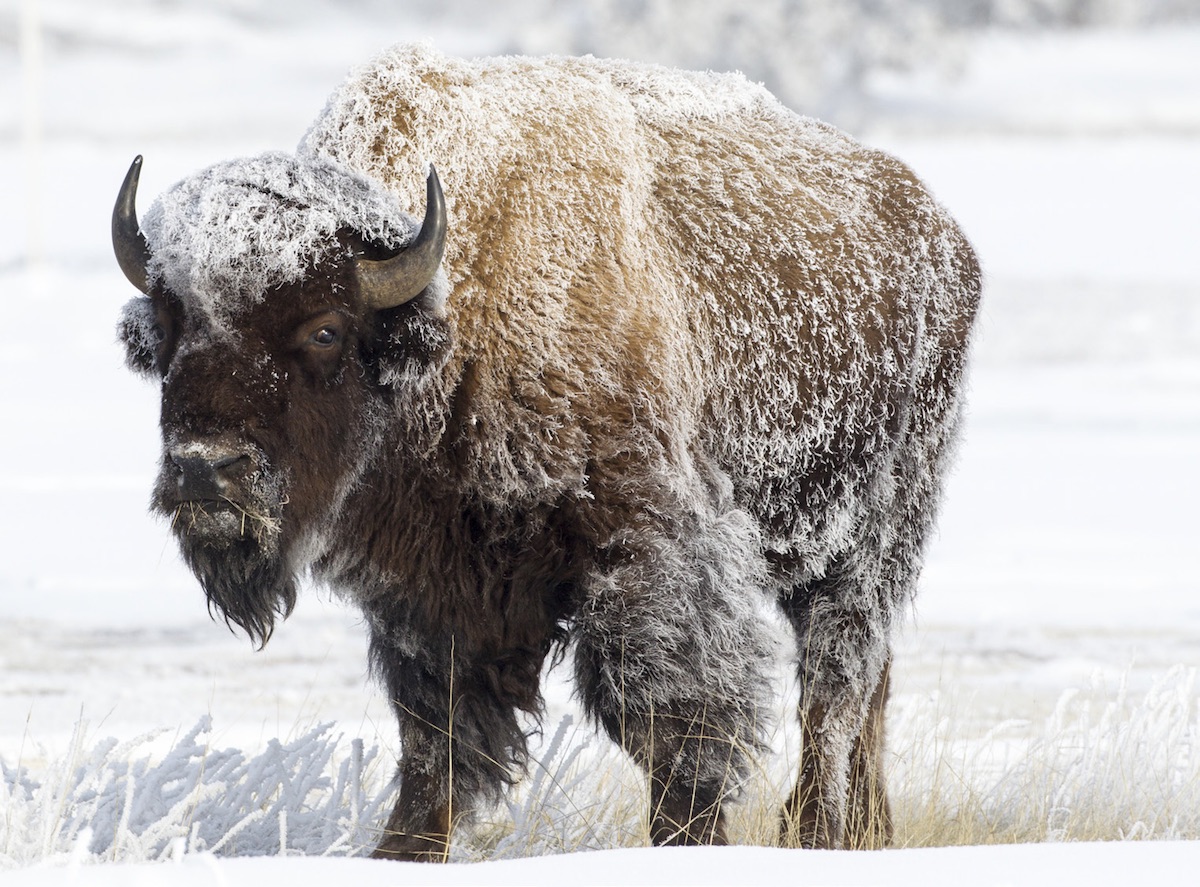
Until then TR’s first buffalo hunt had been a painful misadventure: the hunters had suffered chilling rain, severe sunburn, and, to top it all off, failed to bag a single bison. But even the most disastrous of trips can ultimately show promise.
By now TR’s short hunting trip had turned into seven long, tumultuous days. So when their horses began acting up and were suddenly attracted to something at the end of the gully they were riding through, Roosevelt became excited. Perhaps the horses had sensed an animal somewhere ahead of them. He hoped it would be buffalo.
TR wasted no time springing out of his saddle and quickly walking along the soft creek bed where he found the distinctive hoof-tracks of a big bison bull. advancing a bit farther, he could see the end of the canyon and his prize.
There, upwind of him, was a magnificent buffalo walking along the course of the ravine. Every now and then it stopped, swinging its huge head from side to side. TR’s heart was pounding with excitement as he moved cautiously toward the beast.
Keeping a small hillock between him and his target, he crept up to the crest and looked over. The buffalo was a mere 50 yards away, and this time TR felt confident. He raised his rifle just as the bull raised his head and cocked his tail.
TR knew this was a sign that the beast was ready to take off. He couldn’t let that happen again, so he promptly fired, putting the bullet behind the bull’s shoulder. This time he knew the shot was good, but the massive beast whirled round and, with the agility of a gazelle, charged up the opposite gully.
TR put two more bullets into the fleeing animal, and he could see blood pouring out of its mouth and nostrils as it staggered up and over the rim. He knew it wouldn’t be long before the beast would succumb to its fatal wounds.
TR and Ferris grabbed their horses and trotted over the rim, where they found the great buffalo lying on its side. The two men got to work field-dressing Roosevelt’s first buffalo trophy, and after packing the head, they enjoyed their first real meal in a week.
The hunt had been one of TR’s most arduous adventures but would always remain as one of his most memorable.
 A superb collection of stories that captures the very soul of hunting. For hunters, listening to the accounts of kindred spirits recalling the drama and action that go with good days afield ranks among life’s most pleasurable activities. Here, then, are some of the best hunting tales ever written, stories that sweep from charging lions in the African bush to mountain goats in the mountain crags of the Rockies; from the gallant bird dogs of the Southern pinelands to the great Western hunts of Theodore Roosevelt. Great American Hunting Stories captures the very soul of hunting. With contributions from: Theodore Roosevelt, Nash Buckingham, Archibald Rutledge, Zane Grey, Lieutenant Townsend Whelen, Harold McCracken, Irvin S. Cobb, Edwin Main Post, Horace Kephart, Francis Parkman ,William T. Hornaday, Sc.D, Rex Beach, and more. Shop Now
A superb collection of stories that captures the very soul of hunting. For hunters, listening to the accounts of kindred spirits recalling the drama and action that go with good days afield ranks among life’s most pleasurable activities. Here, then, are some of the best hunting tales ever written, stories that sweep from charging lions in the African bush to mountain goats in the mountain crags of the Rockies; from the gallant bird dogs of the Southern pinelands to the great Western hunts of Theodore Roosevelt. Great American Hunting Stories captures the very soul of hunting. With contributions from: Theodore Roosevelt, Nash Buckingham, Archibald Rutledge, Zane Grey, Lieutenant Townsend Whelen, Harold McCracken, Irvin S. Cobb, Edwin Main Post, Horace Kephart, Francis Parkman ,William T. Hornaday, Sc.D, Rex Beach, and more. Shop Now
